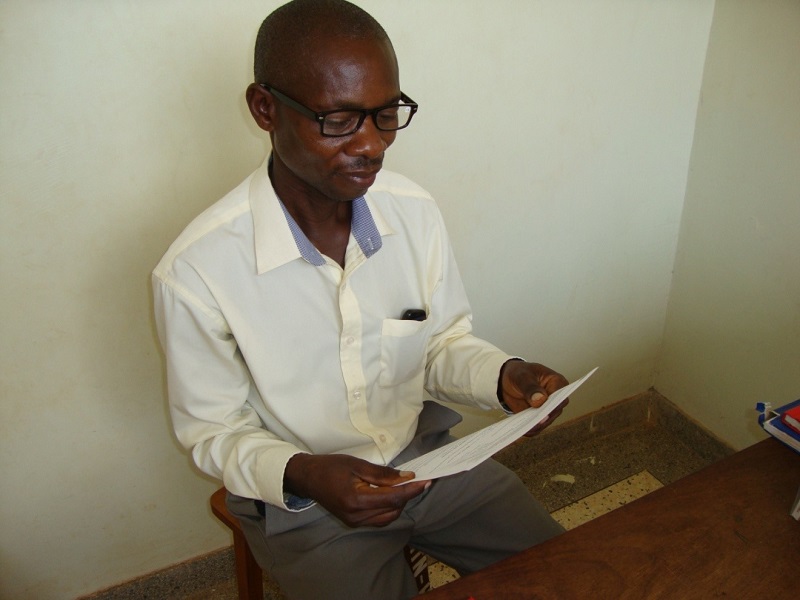Join a powerful, unprecedented alliance for better eye health for all.
Join IAPB-
Choose an alternate language here

Targets (and implementation plans) were developed and agreed upon by all stakeholders. Therefore, local ownership of the project was entrenched from the very beginning and as such agreements (MOUs) were signed with all the project districts before implementation. Importantly these meeting resulted in the adoption of clear roles and responsibilities by all parties which are reviewed at quarterly monitoring and annual stakeholders’ meetings.
An additional outcome of early planning was that steering committee, with membership comprising of the Standard Chartered bank and the three line ministries (Health; Education & Sports; and Gender, Labour & Social Development), was established and meets quarterly. Further, the Ministry was afforded the opportunity to identify and recommend the health region that was in most need of support – particularly with respect to strengthening district eye health services and to integrating them into the government health system.
Now at primary level, services are being implemented from the community to the district level. Here the project sensitized general health workers and community health workers on eye health. They were trained to identify people with eye health conditions and refer them for the necessary services at the eye clinics. Teachers were also sensitised and trained to screen children and refer those who fail to the nearest eye clinic. All trainees were equipped with screening equipment. Even though eye health outreaches are in the district plans for purposes of reducing travel distances for the communities, they were not being implemented due to limited resources. The project continues to support eye workers to conduct outreaches to the lower level health centres so as to ensure that communities at all levels receive eye health services in those health facilities that do not have eye health workers.
During this time Mubende hospital had just been elevated from district to Regional Referral hospital status and as such should provide secondary level health services however, the eye clinic still only provided district level services. The project provided Mubende Hospital with the correct equipment (ophthalmic surgical equipment), training support as well as consumables and medicines so as to enable it to function at the correct level. Further one hospital in each project district also received diagnostic equipment.
As there was no ophthalmologist in the region the project lobbied the Ministry of Health to post a surgeon at the Regional Referral hospital. Surgery is now being conducted at the regional referral hospital and the surgical team is conducting surgical outreaches to the district hospitals thereby bringing services closer to the community. Plans are in place to progressively procure medicines and consumables for surgery through the established government medicine supply system to ensure continuity of services.
Rehabilitation services are also being provided. Two OCO/Refractionists in addition to being trained in paediatric refraction, were also trained in low vision and are providing these services. A low vision section has been established at the eye clinic at Mubende Regional Referral hospital. White canes were distributed after orientation and mobility training which has been held in the project districts. The mobilisation of the blind was done by the District Community Development Offices with supervision from their line ministry. The training was conducted in partnership with the Uganda National Association of the Blind.
At the National level, the project is working with the Ministries of Health; Education & Sports; and Gender, Labour and Social Development and as such, Project focal persons from these ministries work with the project team to supervise and monitor the project activities. These focal persons together form part of the steering committee which monitors project implementation. The project has worked closely together with the Health Promotions department at Ministry of Health to develop IEC materials which will be used across the districts for eye health awareness and sensitization. These materials are now owned by Ministry of Health.
The main challenge that existed and which impacted project delivery from a timing perspective was the lack of key HR. This resulted in a few setbacks, however Ministry of Health approved a surgical team from Mulago National Referral hospital to support the project until the permanent placement was found. Additionally two Clinical Officers have been identified for training in community ophthalmology to become Ophthalmic Clinical Officers. An ophthalmic theatre nurse has also been trained. At this time an ophthalmologist has now been permanently place at Mubende Hospital. These again were fruits of the inclusive planning and engagement that took place at the beginning of the project.
Prior to the implementation of this projects only approximately 4,000 people were receiving eye health services in the region. Of note is that this region did not have an ophthalmologist for over 5 years and as such there was a huge backlog of patients requiring surgical management.
The date the project boasts the following:
1: A total of 3,085 government workers have been trained
2: Four hospitals have been equipped as planned.
3. Over 237,000 children have been screened in school and 77,000 adults have been screened during outreaches.
4: Over 53,000 people have received medical intervention in the eye clinic and 2,500 have had surgical intervention. Over 12,000 glasses have been dispensed.
Therefore by integrating eye health services into the health system, the project has reached over 300,000 adults and children who had not been receiving eye health services. The districts have taken the lead in the planning and implementation activities. As the phase out begins, the project activities are being integrated into the ministry and district plans and budgets to ensure sustainability.
Naomi Nsubuga,
Sub-regional Manager (East Africa)